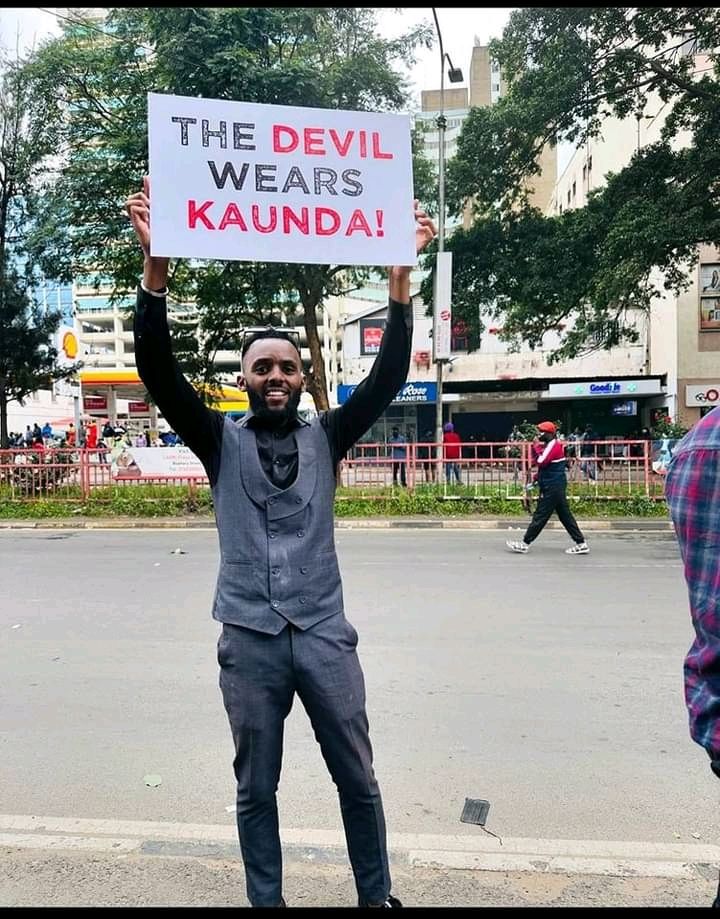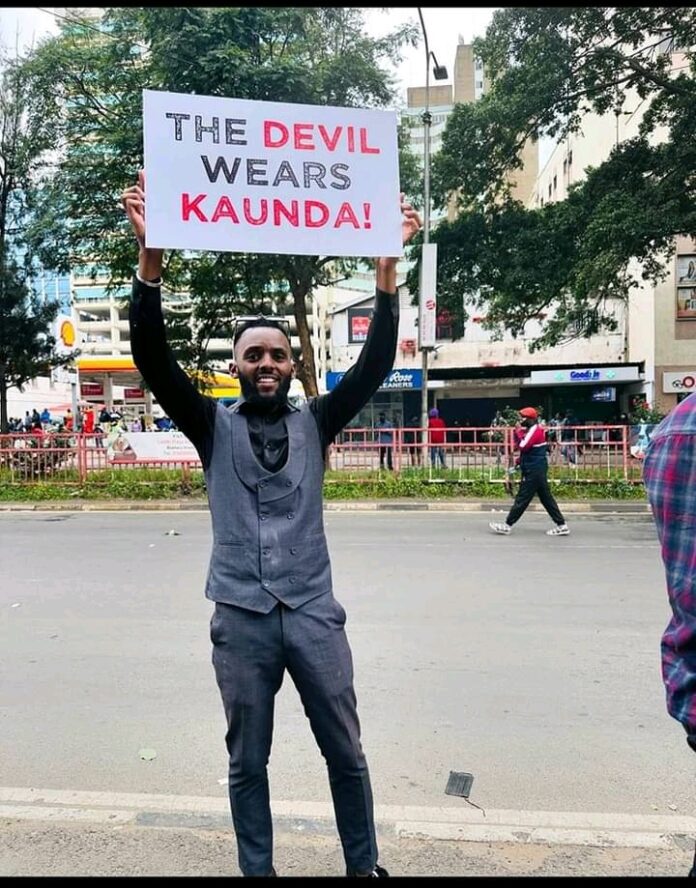GUEST ARTICLE: LUSAKA, ZAMBIA
The Misguided Attack on Kaunda’s Legacy: A Call to Kenyan Youth to Focus on Their Own Struggles
By Njoya Mulonga Tembo, MZIM
June 21, 2024
As the youth of Kenya take to the streets to express their grievances, it is disheartening to see the name of Dr Kenneth Kaunda fondly known as KK, a legendary freedom fighter and Pan Africanist, being dragged through the mud. The placards bearing the phrase “the devil wears Kaunda” are not only misguided but also disrespectful to the legacy of a man who dedicated his life to fighting colonialism, apartheid, and imperialism. We kindly advise the people and Government of the Republic of Kenya through its embassy in Zambia to apologize.
Kenneth Kaunda, the first President of Zambia, was a key figure in African politics and a champion of liberation struggles. During his reign from 1964 to 1991, he took several iconic actions that benefited Kenya and Kenyans:
1. Support for Kenyan Independence: Kaunda actively supported Kenya’s fight for independence from British colonial rule. He provided diplomatic and material support to Kenyan nationalists, including late Jomo Kenyatta. Ask former president Uhuru Kenyatta who is still alive today for more information.
2. Hosting Kenyan Freedom Fighters: Kaunda offered sanctuary to Kenyan freedom fighters. He worked with late Dedan Kimathi, who fought against British colonial rule. Zambia served as a safe haven for Kenyan liberation movements. In 1956/7 the year Kimathi was captured and executed, a Zambian named Mpundu “Zanco” Mutembo was tasked to learn how to forment rebellion that the Mau Mau uprising had been doing in Kenya.
3. Backing the African Liberation Struggle: Kaunda was a founding member of the Organization of African Unity (OAU), precursor to the African Union (AU). He supported liberation movements across Africa, including those in Kenya, fighting against colonialism and apartheid.
4. Economic Cooperation: Kaunda fostered economic cooperation between Zambia and Kenya. He promoted trade and investment, strengthening regional ties and development.
5. Education and Healthcare Support: Kaunda’s government provided scholarships to Kenyan students and supported healthcare initiatives in Kenya, demonstrating his commitment to regional solidarity and development.
6. Mediation and Diplomacy: Kaunda played a mediating role in regional conflicts, including the 1982 coup attempt in Kenya. He used his diplomatic influence to promote peace and stability in the region.
The misuse of Kaunda’s name could be said to have many facets. One thing for sure is that we should not compartmentalize his legacy to a suit type. Kenyan youths and Africa as a whole can derive numerous lessons from this great son of Africa.
Kaunda’s life and leadership offer valuable insights:
– He became President of Zambia at 40, a testament to his vision and leadership potential.
– He lived a long life, despite being exposed to many challenges, and passed on at 97.
– He was not materialistic, choosing a simple life over wealth and extravagance.
– He believed in empowering youths, appointing 21-year-old Vernon Mwaanga as Zambia’s ambassador to the United Nations (UN).
– He stood firm against corruption and upheld his values.
– He embraced vegetarianism, rejecting the oppressive systems of the past. He refused to buy beef through a pigeon hole.
– He united a nation of over 70 tribes with his “One Zambia One Nation” motto.
– Nelson Mandela, a fellow icon, chose to thank KK and Zambia first after his release from prison.
– When Kaunda lost elections in 1991, he peacefully handed over power to his successor, demonstrating his commitment to democracy.
Let us honor Kaunda’s legacy by embracing the lessons he taught us. Let us focus on building a brighter future for Africa, free from corruption, colonialism, and oppression. The youth of Kenya must keep to their own struggles and avoid distractions. Let us celebrate Kaunda’s life and leadership, and strive to emulate his values and principles.
The decision to abandon European dress codes, embraced by the Kenyan Parliament, was a deliberate choice made by Kaunda to reject the symbols of colonialism and embrace African culture. His iconic image, complete with a white handkerchief symbolizing peace, is a testament to his commitment to Pan Africanism.
However, the issues facing Kenya today – undiscerning voting for lack of better words, and the proposed tax hikes and controversial finance bill – require the youth’s attention and action. It is essential to focus on addressing these pressing matters rather than misdirecting energy towards attacking Kaunda’s legacy.
The bills being introduced will not disappear by attacking Prada or Kaunda. Instead, the youth must gather their consciousness and focus on the issues at hand. It is crucial to engage in constructive dialogue, demand accountability from leaders, and work towards finding solutions to the economic and social challenges facing Kenya.
Kaunda’s name deserves respect, and his contributions to the African liberation struggle should not be tarnished by misguided placards and slogans. The youth of Kenya must keep to their own struggles and avoid distractions. Let us honor the past, focus on the present, and build a brighter future for all Africans.


Father, forgive them, for they don’t know what they are doing.
It’s you the AUTHOR who is CONFUSED, that placard is saying “THE devil wears Kaunda Suits” . Meaning the Kenyan president who likes wearing Kaunda SUITS.
When one says, “Take a chill pill”… They don’t mean for you to freeze, nor for you to take any pills. So relax.
The writings on the placard has some ambiguous meaning.It is capable of giving two meanings.It is advisable for us Zambians to pick the one that shows us their internal issues as Kenyans.The subject in their protests is not Kaunda.Kenyans have disliked the badget contents concerning tax if Iam not mistaken so they are discussing themselves not our Kaunda.The safari suit is called Kaunda suite because it has features of Kaunda suits.Some senior government officials in Kenya like wearing Kaunda suite eve their President wears it alot more.The author shouldn’t have gone that far in his writing.
The message on the Placard is vague…
The Devil wears Kaunda!
1.The devil ( Ruto) shouldn’t wear Kaunda who was a great statesman, leader with a lot of virtuous attributes. Ruto falls short of Kaunda’s qualities.
2. The devil ( Ruto ) is a representation of Kaunda’s Evils..The Red color for the Words Devil and Kaunda seems to equate Kaunda with Evil.
The context is important. There have been some mixed views to President Ruto wearing the Kaunda suits.. whatever feelings the Kenyans have on the Kaunda Suit , which am not privy to, can properly interpret the message on the Placard.
I however think the second understanding is more probable, and the Author seems to have gotten it right.